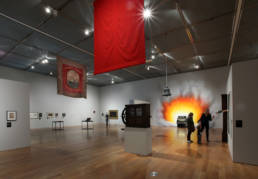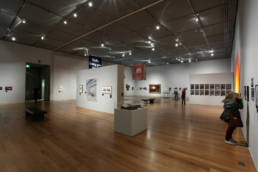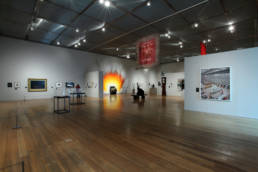All That Is Solid Melts Into Air
Manchester Art Gallery
12 Oct 2013 → 19 Jan 2014
Nottingham Castle
31 Jan 2014 → 21 Apr 2014
Mead Gallery, University of Warwick
2 May 2014 → 21 June 2014
Laing Art Gallery, Newcastle
12 July 2014 → 26 Oct 2014
All That is Solid Melts Into Air was an exhibition for Hayward Touring curated by Jeremy Deller. I was a member of the curatorial support team that also included Gilly Fox, Vanessa North and Lesley Young. The title of the show is a quotation drawn from a lineage of uses from Goethe to Marx & Engels to Berman, and in its modern use generally refers to the individual and societal abstractions brought about through the birth and subsequent dominance of the capitalist mode of production.
The exhibition toured four English industrial cities, Manchester, Coventry, Nottingham and Newcastle-upon-Tyne, and was a contemporary interpretation of the lived experiences of those who were present during the Industrial Revolution as read through their various cultural legacies. It was not a didactic exhibition, but was rather a thought-experiment based on a set of idiosyncratic extrapolations that sought to make new and interesting connections between the cultural practices of present-day de-industrialised Britain, and those that emerged as industrial capitalism swept the country in the early nineteenth century. There was a particular focus on music, Deller riffing on – for example – how the machine-age gave birth to the sounds, images and even venues that have gone on to form our aural and visual experiences of music. This was expressed through curatorial choices such as the juxtaposition of Thomas Horner’s Rolling Rolls of Merthyr Tydfil with the cover of a Judas Priest album, or G F Bragg’s Treforest Tin Works with Gavin Watson’s Slough Centre, End of Night. He also used anecdote as a material in the show, such as telling the story of 17-year-old Antony Frank who lost the tip of two of his fingers in an industrial accident in 1965. His injury made it difficult to play, so he detuned his guitar to ease the pain, leading his bassist colleague to do the same. This lead to an unusually foreboding minor-key sound that became a hallmark of heavy metal music. Antony Frank is better known as Tony Iommi, songwriter for Black Sabbath, Deller describing “his sacrificed fingers” as being “an offering to the machines, creating a new kind of industrial music.” This tale is told alongside reports of injuries to children during the industrial era as they cleaned and repaired still-running machines, and presented in proximity to a juke-box playing noises recorded in factories or men singing at work, and the family trees of rock stars whose recent ancestors lived and worked in parts of the country that relied on heavy industry and who have, themselves, been the first in their family-lines to have de-industrialised occupations.
The exhibition presented a lineage of images of workers, including paintings of urban and agricultural labourers in the 1830s by W. J. Chapman, photographic portraits of iron workers in the 1860s by William Clayton, police mug-shots of street gangs in the 1880s, and photos of bands in the 1980s by Ian Tilton. It approached workplace aesthetics through, for example, the hot apocalyptic visions of the industrial black-country by G. Greatbach to the cold apocalyptic visions of Amazon fulfilment centres by Ben Roberts. It considered textual expressions of working life through a variety of forms including factory signs, trades union banners, broadsides and text messages sent to workers on zero-hours contracts. Essentially, the show compressed what are long-stretching lineages into short aesthetic chains, which brought about shocks as a result of both their remarkable contrasts and their remarkable similarities.




